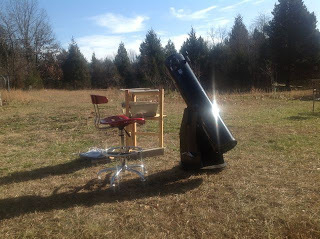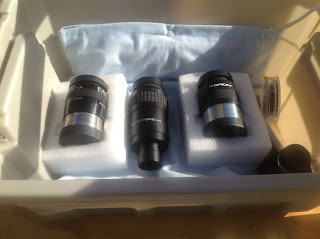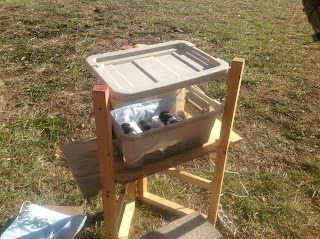Buying a Telescope
 |
| My scope, chair and work stand with EP case. |
This is for a budget of about $600. For most beginners I would suggest going with an 8" dobsonian that will run about $360 If you are at all interested in looking at fainter objects such as the Messier or Herschel objects this would be the minimum size. Many of the faint objects would be visible in a 6" but would be very difficult. There's nothing wrong with a challenge of course but even with the 8" scope that I have they are difficult. Most of these are distant galaxies and planetary nebula and while it is expected that they would be very faint and small I think 8" is the cutoff for seeing something that is actually worth seeing. My scope, purchased in September 2012 from Orion, is the XT8.
A note about mounts. Dobsonians are ground mounted newtonian reflector scopes that rely on a mirror for light gathering. They are the best choice for maximum light gathering for low cost. You can get a tripod mounted reflector but in my opinion the Dobsonian is the easiest to use and probably the most sturdy choice if you've got kids that will be viewing. When stored in the vertical position they don't take much space at all, about the diameter of a chair. I would avoid the tripod mounted refractor scopes often sold in department stores. They use an optical lens for light gathering and will be much smaller in diameter giving you much less light gathering.
Something to consider at this point is your local light pollution. If you are in a city or suburbia with lots of light pollution you'll be much more limited in what you can see. In this case the fainter objects will be more difficult to find. If you are more distant from light pollution, say 10 minutes outside of a small town or 45 minutes outside of a large city, you probably have darker skies and in that case a larger scope would be worth the money. Here's a map of light pollution in the U.S. You can find a larger version via Bing or Google. Some folks that are in cities buy a scope knowing that they will travel to a dark sky site every so often.
If your primary interest is our solar system's planets and the moon the 6" will serve you well. That said, you only really get to see any detail with Jupiter and Saturn. The other planets only resolve to tiny disks/dots and won't have much detail. In my opinion you'll have a much longer term interest in amateur astronomy if you go with an 8" and learn to find and appreciate the faint objects in the lists above. Learning to star hop is kind of like reading the stars and for me has been a very gratifying, fun and interesting process.
 |
| Eye pieces and filters sitting on heating pad in case |
To give you an idea of useful magnifications here's what I've got: 26mm (good for large objects such as Orion's Nebula and the Andromeda Galaxy); 18mm which gives you a nice step up to a more magnified view of objects; 11mm (my next purchase) is the next step up for a great view of Saturn and Jupiter as well as some of the fainter galaxies; 5mm gives the most magnified view of Jupiter and Saturn. The problem with higher magnification EPs such as the 5mm is that you have to have the very best atmospheric conditions to use it. Many nights it won't be useful at all and will give you a very fuzzy image. There will be many nights though that have good seeing conditions and on those nights you'll get a fantastic view of the clouds of Jupiter and rings of Saturn. Also, it is with these higher magnification EPs where the wider field of view becomes much more useful because it makes finding the object easier and keeps it in the field of view longer.
 |
| Home made workstation. The case lid is held in place by several screws on the top tier. Second heating pad is put there with laptop on top for recording observations directly into database. |
Just a quick edit to address an important point brought up by @Bas Waanders over on Google+ which is that what you'll see through an amateur telescope is a far, far cry from the images you see on the internet!! The human eye has a very limited ability to gather color in such low light so most of what you will see is gray scale. You won't get nearly the detail and most galaxies, especially the very distant ones are just faint smudges. With a lot of practice your eyes do become much better at seeing some of the detail but don't buy a scope expecting the epic detail and color via the images you've seen as they are many stacked 30 second exposures. That said, some objects are truly fantastic in a small scope, for example the Orion Nebula is stunning even without the color. Also, the Eagle and Lagoon Nebulas and quite a few of the globular clusters. Andromeda looks pretty good too though does not have the color or detail from images.